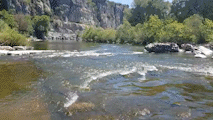In social animals (including humans), silence can be a sign of danger. Many social animals produce seemingly haphazard sounds which are known as contact calls. These are a mixture of various sounds, accompanying the group's everyday business (for example, foraging, feeding), and they are used to maintain audio contact with the members of the group. Some social animal species communicate the signal of potential danger by stopping contact calls and freezing, without the use of alarm calls, through silence. Charles Darwin wrote about this in relation with wild horse and cattle Human humming could have been a contact method that early humans used to avoid silence. According to his suggestion, humans find prolonged silence distressing (suggesting danger to them). This may help explain why lone humans in relative sonic isolation feel a sense of comfort from humming, whistling, talking to themselves, or having the TV or radio on.
 | |
| no sound |
















































